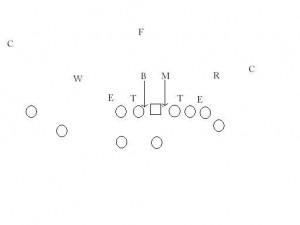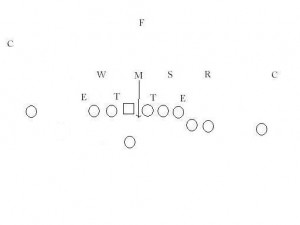Defeating Blitzes
Defeating the Blitz with shotgun wing-t
We get a lot of questions about the A-gap blitz or LBer run throughs. Will it shutdown the bucksweep and its complimentary plays? The answer is… only if you let it. We talk about this extensively in the video series. Running the wing-t from the shotgun, you do not have a fullback to fill for the pulling guards. But you have more options with formations and reads. We have been running the shotgun wing-t since 2005, in the last 7 years we have been to 6 state championships and a 33 game win streak. Teams have tried many different schemes, so we have seen literally every defense and blitz ever invented since then. We used to see the A-gap blitz a lot, but is not a magic blitz to stop the wing-t.
First a few words on blitzes: Blitzes work well on offenses that are not prepared for them. We spend a lot of time against blitzes and aggressive defenses. We draw up cards for our scout team that either blitzes into the play or shows the play so the defense can aggressively fill their gaps fast. This forces our offense to take perfect steps and play faster. By the end of the year, and into the playoffs we are running the bucksweep fast and there is nothing we have not seen as far as blitzes and fronts. If your offense’s first look at an aggressive defense is game time, then you are in trouble. Every offense must have one or two base plays that are their go to plays. You must be able to block these plays versus any defense and any stunt and be sound. Ours is usually bucksweep and trap. But this will vary depending on personnel. Some years our base plays are bucksweep and belly, some years it is bucksweep and jet sweep. The A-gap blitz can lead to a tackle for a loss, or a big play for the offense, we’ll explain later why the A-gap blitz is a bad idea against the bucksweep. The A-gap blitz can be effective, however, on our non-base plays like the criss-cross reverse and waggle because we don’t have the practice time to get great at those plays verses the blitz. We’ll explain later how we mitigate this threat. So from experience we have found that the A-gap blitz verses the bucksweep in not a good idea. It usually ends up a big play for the offense. The A-gap blitz verses the Criss-cross can be effective and can lead to a fumble. We do not like running the criss-cross against inside blitzes. We mitigate the blitz threat by running the play with a “No Play” tempo. The QB tries to get the defense to jump off sides if they don’t then they usually declare their blitz. This is covered in the video series… The waggle is good verses strong side blitzes but risky verses weak side A-gap blitzes, depending on the defensive front. With a mobile quarter back, however, you have a good chance of getting a big play. We have also found that the bucksweep fake on the waggle can act like a block, allowing our QB to get to the edge. So we will run the waggle against A-gap blitzing teams. We will also mitigate the threat of a weak side A-gap blitz by running our waggle with 2 WRs on the quick side and our TE/Wing to the other. This forces some defenses to reduce a LBer. If they don’t we either have man coverage or an open WR.
Back to the Bucksweep and the inside blitz:
First off, the bucksweep from the gun has 3 options to it, the bucksweep, the QB pull and the bubble screen. So there have been times when we have faced a blitz or an overload that I know we can’t block, only to have the QB pull or throw the bubble screen for a big gain. If we had run the same play under center, the defense would have blown up the play and we would have lost yardage. So with the bubble and the read options, we can limit to a certain extent what the defense can do.
We can use a multitude of formations that will cause the defense to be unsound if they choose to blitz. They can man up, but with our empty sets we have 5 eligible receivers at the line of scrimmage. They better have a sound cover scheme or risk a big play. The defense is now in the same situation the offense is in, we can risk running the criss cross reverse against the blitz and hope for a big play. Same thing the defense is now faced with, risk uncovering a receiver and hope for a big play. The payoff is now in the offenses favor. The big play the defense can get is a tackle for a 4 yard loss, the big play the offense can get is a 70 yard TD.
Defeating the A-gap blitz using the bucksweep
Here is why we like running the bucksweep versus A-gap blitzes. The inside LBers are 4 yards deep (minimum) and we are 4 yards deep. So we are 8 yards apart at the snap of the ball. Our HB has 3 yards to get to the mesh and another yard to get past the A gap and clear the LBer. The blitzing LB also has to avoid the QG who is pulling. So that’s why we don’t usually have problems with that. If we do we can get into some of our Empty packages (no backs, QB runs the bucksweep). Now, the Mike LBer is 8 yards from the QB at the snap of the ball and the QB has 1 yard to clear the A-gap. If the MLB makes the play then he is way better than you are and you are going to lose the game no matter what you run. What happens when you blitz the A-gaps on the bucksweep from the gun, is that you cause the offense to gain a blocker since we do not have to block the blitzing MLB.
If the MLB sneaks up to blitz the A-gap, then you have a problem and he will get to the mesh. That leads us to the blitz rule: If our Strong Guards sees his LB sneak up, he makes a “stay” call. He stays and blocks him. So essentially he exchanges assignments with the backside Guard. The QG will now kicks out the force. What this does is speed up the bucksweep for the offense and often leads to big plays. The HB does not have to slow down slightly for the QG to turn it up and look inside to block the MLB because he is already blocked. The QG kicks out and the HB can hit the hole quicker. (For a good look at the “stay” call go to Youtube and type in “shotgun wing-t” and there is a clip of this call on the video: “MCA clinic A”)
So we love running the bucksweep against the A-gap blitz. Now the defense has to decide is it worth running this blitz for a chance to blow up our Criss-Cross reverse play.
Other things we do against blitzing teams:
Also good for inside blitzes are empty sets. The plays are faster and it forces the defense to have sound coverages, since we have 5 eligible receivers at the line of scrimmage.
Another blitz beater is to run bunched wing sets and fake the criss cross reverse to the outside wing as the QB runs the bucksweep. It freezes the LBers or you can Wham block the blitzing LBer to give him something to think about…
We like the bucksweep power against inside blitz. From under center your SG stays and blocks and the FB kicks out the first threat past the wing. You can also run this from gun. Lots of ways to do it… We usually have a weakside wing go in motion to the strong side and kick out first threat past the strong side wing.
Screens are great versus A-gap blitz, especially the Fire or Tunnel screen. We found that the defender who makes the most tackles on our fire screen is one of the inside backers. If they stunt, it makes our job easier. (see the article on this web page for the fire screen)
We also will run the Dart play. We pull the QT and he climbs to block the Mike LBer. If he is blitzing, he gets kicked out like a trap and the play hits quick.
Flopping the TE and Wing can cause problems with the defense. Align them on one side, flop to the other and run your play. This messes with defenses that have a strong side or quick side blitz. Are they well schooled enough to make their Right/Left call and reverse their blitz, or will they just run it and turn their strong side blitz into a weak side blitz, and essentially limiting what blitz the coordinator wanted. Notice the Strong-side Inside LB is NOW the backside Inside LB in the following clip:
If they are kicking our butt blitzing and we are really stubborn and still want to run the bucksweep anyways, then we will run the bucksweep from the single wing. We put our two guards in the backfield. The two guards on the L.O.S. block down. The Guards in the Backfield pull. QB catches and runs bucksweep. This is very good against A-gap blitz.
We also run a lot of Tempo. We try to break the huddle and either snap the ball or put a man in motion within 4 seconds. This is great for teams that align Strong/Weak side, because they have to find the TE, recognize the formation, backfield, and then get set and remember the blitz and gap they are assigned, all within 4 seconds. This can be a challenge for the defense and can slow down the blitz and aggressiveness of the defense. This tempo is covered in the video series.
If after all of this, they can still effectively blitz the bucksweep series, then stop running the series and go to the Jet or Rocket, two very good blitz beaters. If they don’t get out of the blitz when you run the motion, you have an advantage, because you will not have to block the blitzers and they lose defenders that would normally be pursuing to the ball. If defenses are calling off their blitzes when you run jet or rocket motion, you now have another option if the blitzes are giving you problems. With the shotgun wing-t you can put a WR in Jet motion and run bucksweep, Criss-cross, or waggle.
We will also go into every game with a blitz beater pass as well. Most defenses have blitz tendencies like offenses have tendencies. We try to run the play during one of these tendencies. So chart the defense. Make note if they like to stunt from the wide side of the field or in certain down and distances, or field positions.



